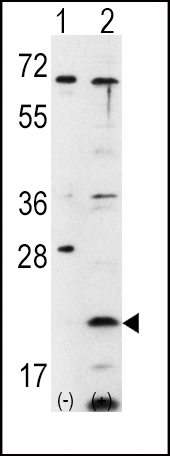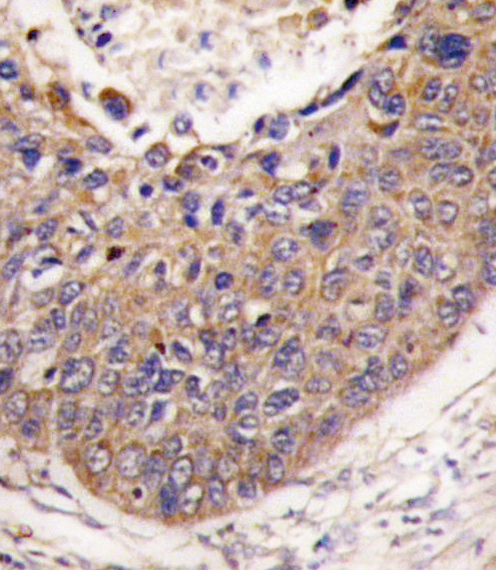Frataxin Rabbit pAb
Frataxin Rabbit pAb
- 产品详情
- 实验流程
- 背景知识
Application
| WB, IHC-P, IHC-F, IF |
|---|---|
| Primary Accession | Q16595 |
| Reactivity | Rat, Pig, Chicken, Dog |
| Host | Rabbit |
| Clonality | Polyclonal |
| Calculated MW | 23135 Da |
| Physical State | Liquid |
| Immunogen | KLH conjugated synthetic peptide derived from human Frataxin |
| Epitope Specificity | 110-210/210 |
| Isotype | IgG |
| Purity | affinity purified by Protein A |
| Buffer | 0.01M TBS (pH7.4) with 1% BSA, 0.02% Proclin300 and 50% Glycerol. |
| SUBCELLULAR LOCATION | Cytoplasm. Mitochondrion. PubMed:18725397 reports localization exclusively in mitochondria. |
| SIMILARITY | Belongs to the frataxin family. |
| SUBUNIT | Belongs to the frataxin family. |
| Post-translational modifications | Processed in two steps by mitochondrial processing peptidase (MPP). MPP first cleaves the precursor to intermediate form and subsequently converts the intermediate to yield frataxin mature form (frataxin(81-210)) which is the predominant form. The additional forms, frataxin(56-210) and frataxin(78-210), seem to be produced when the normal maturation process is impaired; their physiological relevance is unsure. |
| DISEASE | Defects in FXN are the cause of Friedreich ataxia (FRDA) [MIM:229300]. FRDA is an autosomal recessive, progressive degenerative disease characterized by neurodegeneration and cardiomyopathy it is the most common inherited ataxia. The disorder is usually manifest before adolescence and is generally characterized by incoordination of limb movements, dysarthria, nystagmus, diminished or absent tendon reflexes, Babinski sign, impairment of position and vibratory senses, scoliosis, pes cavus, and hammer toe. In most patients, FRDA is due to GAA triplet repeat expansions in the first intron of the frataxin gene. But in some cases the disease is due to mutations in the coding region. [MISCELLANEOUS] The unusual migration profile of mature frataxin on SDS-PAGE due to its acidic N-terminus most likely contributed to conflicting reports for the N-terminus of the mature protein. Unlike prokaryotic and yeast frataxin homologs, which self-assemble at high iron concentrations, oligomerization of human frataxin is not induced by iron. The existence of a specialized mitochondrial ferritin in mammalia (FTMT) is suggesting that iron storage would be redundant function, at least in mammalian mitochondria. |
| Important Note | This product as supplied is intended for research use only, not for use in human, therapeutic or diagnostic applications. |
| Background Descriptions | Friedreich ataxia is a progressive neurodegenerative disorder caused by loss of function mutations in the frataxin gene. The human frataxin gene maps to chromosome 9q13.The frataxin gene encodes a mitochondrial protein of the same name. Frataxin assembles into a stable homopolymer with iron-binding capabilities. When expressed in E. Coli human frataxin binds iron atoms at a rate of 10 iron atoms per 1 molecule of the frataxin polymer. Thus, frataxin appears to function in some capacity for iron-storage for the mitochondria. Frataxin may also function as an activator of oxidative phosphorylation to increase mitochondrial membrane potential and elevate cellular ATP. Frataxin is expressed in tissues with high metabolic activity including heart, liver and brown fat. |
| Gene ID | 2395 |
|---|---|
| Other Names | Frataxin, mitochondrial, 1.16.3.1, Friedreich ataxia protein, Fxn, Frataxin intermediate form, i-FXN, Frataxin(56-210), m56-FXN, Frataxin(78-210), d-FXN, m78-FXN, Frataxin mature form, Frataxin(81-210), m81-FXN, Extramitochondrial frataxin, FXN (HGNC:3951), FRDA, X25 |
| Target/Specificity | Expressed in the heart, peripheral blood lymphocytes and dermal fibroblasts. |
| Dilution | WB=1:500-2000,IHC-P=1:100-500,IHC-F=1:100-500,IF=1:100-500 |
| Storage | Store at -20 °C for one year. Avoid repeated freeze/thaw cycles. When reconstituted in sterile pH 7.4 0.01M PBS or diluent of antibody the antibody is stable for at least two weeks at 2-4 °C. |
| Name | FXN (HGNC:3951) |
|---|---|
| Synonyms | FRDA, X25 |
| Function | [Frataxin mature form]: Functions as an activator of persulfide transfer to the scaffoding protein ISCU as component of the core iron-sulfur cluster (ISC) assembly complex and participates to the [2Fe-2S] cluster assembly (PubMed:12785837, PubMed:24971490). Accelerates sulfur transfer from NFS1 persulfide intermediate to ISCU and to small thiols such as L-cysteine and glutathione leading to persulfuration of these thiols and ultimately sulfide release (PubMed:24971490). Binds ferrous ion and is released from FXN upon the addition of both L-cysteine and reduced FDX2 during [2Fe-2S] cluster assembly (PubMed:29576242). The core iron-sulfur cluster (ISC) assembly complex is involved in the de novo synthesis of a [2Fe-2S] cluster, the first step of the mitochondrial iron-sulfur protein biogenesis. This process is initiated by the cysteine desulfurase complex (NFS1:LYRM4:NDUFAB1) that produces persulfide which is delivered on the scaffold protein ISCU in a FXN-dependent manner. Then this complex is stabilized by FDX2 which provides reducing equivalents to accomplish the [2Fe-2S] cluster assembly. Finally, the [2Fe-2S] cluster is transferred from ISCU to chaperone proteins, including HSCB, HSPA9 and GLRX5 (By similarity). May play a role in the protection against iron- catalyzed oxidative stress through its ability to catalyze the oxidation of Fe(2+) to Fe(3+); the oligomeric form but not the monomeric form has in vitro ferroxidase activity (PubMed:15641778). May be able to store large amounts of iron in the form of a ferrihydrite mineral by oligomerization; however, the physiological relevance is unsure as reports are conflicting and the function has only been shown using heterologous overexpression systems (PubMed:11823441, PubMed:12755598). May function as an iron chaperone protein that protects the aconitase [4Fe-4S]2+ cluster from disassembly and promotes enzyme reactivation (PubMed:15247478). May play a role as a high affinity iron binding partner for FECH that is capable of both delivering iron to ferrochelatase and mediating the terminal step in mitochondrial heme biosynthesis (PubMed:15123683, PubMed:16239244). |
| Cellular Location | [Frataxin mature form]: Mitochondrion |
| Tissue Location | Expressed in the heart, peripheral blood lymphocytes and dermal fibroblasts. |
For Research Use Only. Not For Use In Diagnostic Procedures.
Provided below are standard protocols that you may find useful for product applications.
BACKGROUND
Friedreich ataxia is a progressive neurodegenerative disorder caused by loss of function mutations in the frataxin gene. The human frataxin gene maps to chromosome 9q13.The frataxin gene encodes a mitochondrial protein of the same name. Frataxin assembles into a stable homopolymer with iron-binding capabilities. When expressed in E. Coli human frataxin binds iron atoms at a rate of 10 iron atoms per 1 molecule of the frataxin polymer. Thus, frataxin appears to function in some capacity for iron-storage for the mitochondria. Frataxin may also function as an activator of oxidative phosphorylation to increase mitochondrial membrane potential and elevate cellular ATP. Frataxin is expressed in tissues with high metabolic activity including heart, liver and brown fat.
终于等到您。ABCEPTA(百远生物)抗体产品。
点击下方“我要评价 ”按钮提交您的反馈信息,您的反馈和评价是我们最宝贵的财富之一,
我们将在1-3个工作日内处理您的反馈信息。
如有疑问,联系:0512-88856768 tech-china@abcepta.com.























 癌症的基本特征包括细胞增殖、血管生成、迁移、凋亡逃避机制和细胞永生等。找到癌症发生过程中这些通路的关键标记物和对应的抗体用于检测至关重要。
癌症的基本特征包括细胞增殖、血管生成、迁移、凋亡逃避机制和细胞永生等。找到癌症发生过程中这些通路的关键标记物和对应的抗体用于检测至关重要。 为您推荐一个泛素化位点预测神器——泛素化分析工具,可以为您的蛋白的泛素化位点作出预测和评分。
为您推荐一个泛素化位点预测神器——泛素化分析工具,可以为您的蛋白的泛素化位点作出预测和评分。 细胞自噬受体图形绘图工具为你的蛋白的细胞受体结合位点作出预测和评分,识别结合到自噬通路中的蛋白是非常重要的,便于让我们理解自噬在正常生理、病理过程中的作用,如发育、细胞分化、神经退化性疾病、压力条件下、感染和癌症。
细胞自噬受体图形绘图工具为你的蛋白的细胞受体结合位点作出预测和评分,识别结合到自噬通路中的蛋白是非常重要的,便于让我们理解自噬在正常生理、病理过程中的作用,如发育、细胞分化、神经退化性疾病、压力条件下、感染和癌症。







